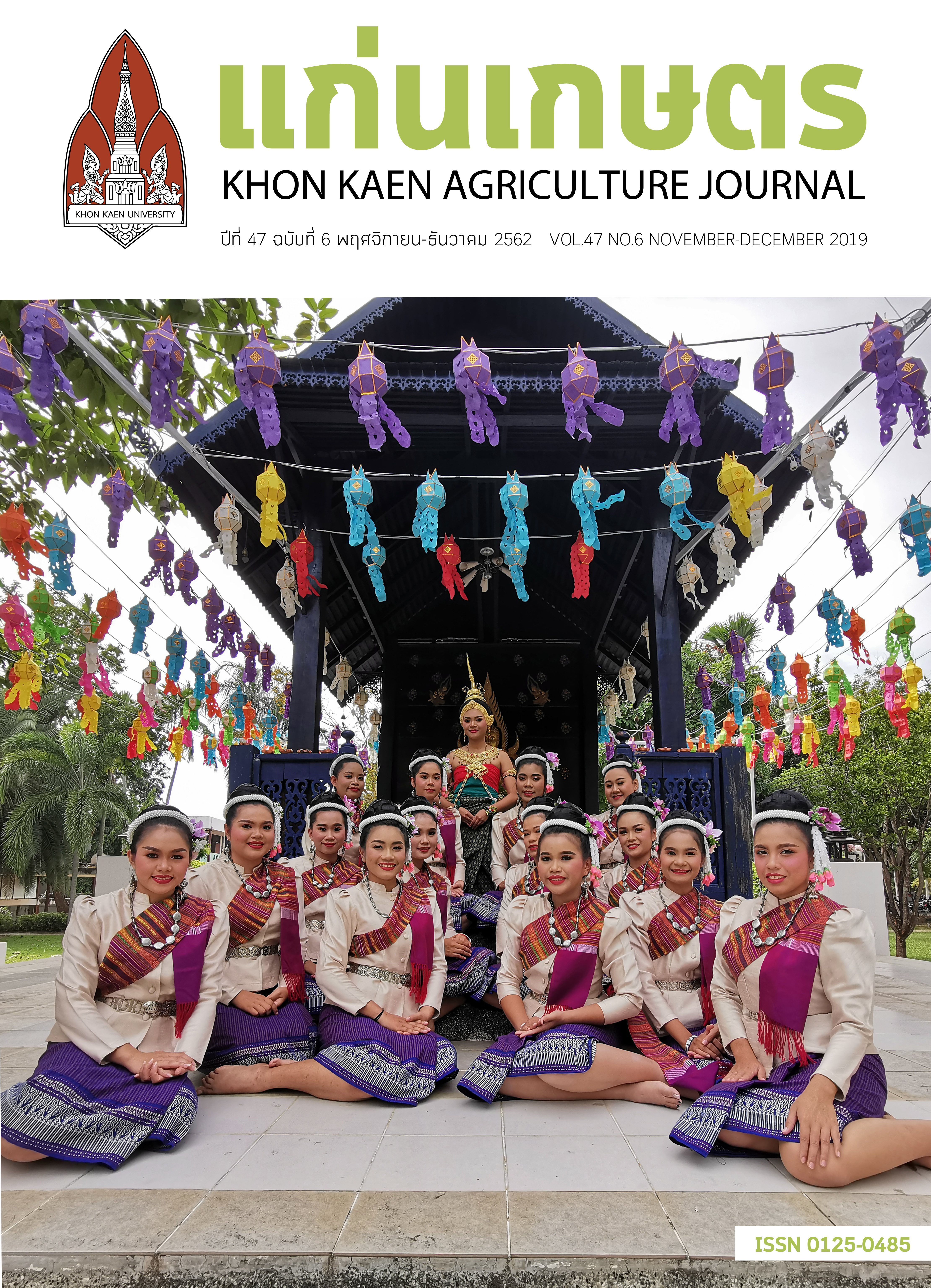ประสิทธิภาพของสารไดโนทีฟูแรนต่อการกำจัดเพลี้ยจักจั่นลายจุดสีน้ำตาล Matsumuratettix hiroglyphicus แมลงพาหะนำโรคใบขาวอ้อย
Main Article Content
บทคัดย่อ
โรคใบขาวอ้อยเป็นโรคระบาดที่สร้างความเสียหายอย่างมากต่ออุตสาหกรรมอ้อยโดยมีเพลี้ยจักจั่นลายจุดสีน้ำตาลเป็นแมลงพาหะนำโรคชนิดนี้ วิธีการหนึ่งที่ใช้ในการตัดวงจรการแพร่ระบาดของโรค คือ การกำจัดแมลงพาหะโดยใช้สารเคมีกำจัดแมลง การศึกษานี้มีวัตถุประสงค์เพื่อประเมินประสิทธิภาพของสารไดโนทีฟูแรนต่อการกำจัดเพลี้ยจักจั่นลายจุดสีน้ำตาลที่เก็บมาจากพื้นที่ 4 จังหวัด ได้แก่ อุดรธานี นครราชสีมา กาญจนบุรี และกำแพงเพชร แมลงพาหะที่มีความไวหรืออ่อนแอต่อสารไดโนทีฟูแรนสูงที่สุดและต่ำที่สุด คือแมลงพาหะที่เก็บมาจากจังหวัดกำแพงเพชร และอุดรธานีซึ่งแสดงค่า LC50 ต่ำที่สุดและสูงที่สุด คือ 0.22 และ 1.27 ppm ที่ระยะเวลา 48 ชม.หลังทดสอบ ตามลำดับ แต่อย่างไรก็ตามสารไดโนทีฟูแรนที่ระดับความเข้มข้น 10 ppm สามารถออกฤทธิ์ในการกำจัดเพลี้ยจักจั่นลายจุดสีน้ำตาลได้เกือบ 100%
Article Details
รูปแบบการอ้างอิง
เหมือนวอน ว., & หาญบุญทรง ย. . (2019). ประสิทธิภาพของสารไดโนทีฟูแรนต่อการกำจัดเพลี้ยจักจั่นลายจุดสีน้ำตาล Matsumuratettix hiroglyphicus แมลงพาหะนำโรคใบขาวอ้อย. วารสารแก่นเกษตร, 47(6), 1337–1342. สืบค้น จาก https://li01.tci-thaijo.org/index.php/agkasetkaj/article/view/250056
ประเภทบทความ
บทความวิจัย (research article)
เอกสารอ้างอิง
วรากร ภู่หนู และ ยุพา หาญบุญทรง. 2559. ประสิทธิภาพของสารฆ่าแมลงต่อเพลี้ยจักจั่นพาหะโรคใบขาวอ้อย. แก่นเกษตร 44 ฉบับพิเศษ 1: 66-72.
ศักดิ์ชัย คุณมี และ ยุพา หาญบุญทรง. 2561. การใช้สารฆ่าแมลงที่เหมาะสมต่อช่วงอายุอ้อยเพื่อการป้องกันแมลงพาหะ Matsumuratettix hiroglyphicus (Matsumura) นำโรคใบขาวอ้อย. แก่นเกษตร 46 ฉบับพิเศษ 1: 183-188.
Arthur, F.H. and E. A. Fontenot. 2013. Efficacy of dinotefuran (Alpine® spray and dust) on six species of stored product insects. Journal of Stored Products Research 55: 55-61.
Corbel, V., M.S. Zaim, and J.M. Hougard. 2004. Dinotefuran: a potential neonicotinoid insecticide against resistant mosquitoes. Journal of Medical Entomology 41: 712-717.
Hanboonsong, Y. and Y. Kobori. 2017. Effects of selected insecticides on Matsumuratettix hiroglyphicus(Matsumura), a vector of sugarcane white leaf disease, and on two natural enemies of the sugarcane stem borer in sugarcane fields. Sugar Tech 19: 573-578.
Hanboonsong, Y., C. Choosai, S. Panyim, and S. Damak. 2002. Transovarial transmission of sugarcane white leaf phytoplasma in the insect vector Matsumuratettix hiroglyphicus (Matsumura). Insect Molecular Biology 11: 97-103.
Hanboonsong, Y., W. Ratthison, C. Choosai, and P. Sirithorn. 2006. Transmission of sugarcane white leaf phytoplasma by Yamatotettixflavovittatus, a new leafhopper vector. Journal of Economic Entomology 99: 1531-1537.
Kiriyama, K. and K. Nishimura. 2002. Structural effects of dinotefuran and analogues in insecticidal and neural activities. Pest Management Science 58: 669-676.
Mokbel, E. S. and A. I. Mohamed. 2009. Development of resistance in field strain of Aphis craccivora to the dinotefuran insecticides from the new class neonicotinoids and its effect on some enzymes content. Egyptian Academic Journal of Biological Science 1: 65-69.
Qu, C., W. Zhang, F. Li, G. Tetreau, C. Luo and R. Wang. 2017. Lethal and sublethal effects of dinotefuran on two invasive whiteflies, Bemisia tabaci (Hemiptera: Aleyrodidae). Journal of Asia-Pacific Entomology 20: 325-330.
SAS Institute. 2000. SAS Online Doc, version 8. SAS Institute, Cary, NC.Wakita, T., K. Kinoshita, E. Yamada, N. Yasui, N. Kawahara, A. Naoi, M. Nakaya, K. Ebihara, H. Matsuno and K. Kodaka. 2003. The discovery of dinotefuran: a novel neonicotinoid. Pest Management Science 59: 1016-1022.
ศักดิ์ชัย คุณมี และ ยุพา หาญบุญทรง. 2561. การใช้สารฆ่าแมลงที่เหมาะสมต่อช่วงอายุอ้อยเพื่อการป้องกันแมลงพาหะ Matsumuratettix hiroglyphicus (Matsumura) นำโรคใบขาวอ้อย. แก่นเกษตร 46 ฉบับพิเศษ 1: 183-188.
Arthur, F.H. and E. A. Fontenot. 2013. Efficacy of dinotefuran (Alpine® spray and dust) on six species of stored product insects. Journal of Stored Products Research 55: 55-61.
Corbel, V., M.S. Zaim, and J.M. Hougard. 2004. Dinotefuran: a potential neonicotinoid insecticide against resistant mosquitoes. Journal of Medical Entomology 41: 712-717.
Hanboonsong, Y. and Y. Kobori. 2017. Effects of selected insecticides on Matsumuratettix hiroglyphicus(Matsumura), a vector of sugarcane white leaf disease, and on two natural enemies of the sugarcane stem borer in sugarcane fields. Sugar Tech 19: 573-578.
Hanboonsong, Y., C. Choosai, S. Panyim, and S. Damak. 2002. Transovarial transmission of sugarcane white leaf phytoplasma in the insect vector Matsumuratettix hiroglyphicus (Matsumura). Insect Molecular Biology 11: 97-103.
Hanboonsong, Y., W. Ratthison, C. Choosai, and P. Sirithorn. 2006. Transmission of sugarcane white leaf phytoplasma by Yamatotettixflavovittatus, a new leafhopper vector. Journal of Economic Entomology 99: 1531-1537.
Kiriyama, K. and K. Nishimura. 2002. Structural effects of dinotefuran and analogues in insecticidal and neural activities. Pest Management Science 58: 669-676.
Mokbel, E. S. and A. I. Mohamed. 2009. Development of resistance in field strain of Aphis craccivora to the dinotefuran insecticides from the new class neonicotinoids and its effect on some enzymes content. Egyptian Academic Journal of Biological Science 1: 65-69.
Qu, C., W. Zhang, F. Li, G. Tetreau, C. Luo and R. Wang. 2017. Lethal and sublethal effects of dinotefuran on two invasive whiteflies, Bemisia tabaci (Hemiptera: Aleyrodidae). Journal of Asia-Pacific Entomology 20: 325-330.
SAS Institute. 2000. SAS Online Doc, version 8. SAS Institute, Cary, NC.Wakita, T., K. Kinoshita, E. Yamada, N. Yasui, N. Kawahara, A. Naoi, M. Nakaya, K. Ebihara, H. Matsuno and K. Kodaka. 2003. The discovery of dinotefuran: a novel neonicotinoid. Pest Management Science 59: 1016-1022.


